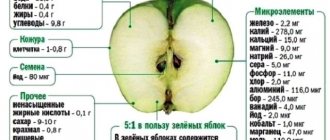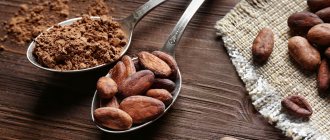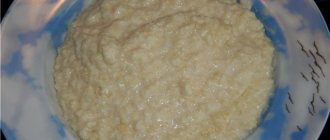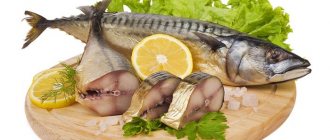Fish is one of the main products in children's diets. What are its benefits and harms? What tasty and healthy dishes can you prepare for children?
Fish is a very healthy product that should definitely be in your baby’s diet. Fish for children is recommended by nutritionists as a source of easily digestible protein, minerals and vitamins, and polyunsaturated acids. Due to the absence of coarse connective fibers in the fish pulp, the product is absorbed almost completely - 93-98 percent. Meat protein is absorbed within 87-89 percent.
The benefits and harms of fish
ads
In terms of nutritional value, fish can be compared to meat, but it is more easily absorbed by the body. The product contains a number of vitamins that are beneficial for the baby: B vitamins, vitamin A and D. In addition, it contains other useful substances: phosphorus, potassium, magnesium, calcium, iron, fluorine, sodium. The iodine contained in the product has a beneficial effect on the development of mental abilities and the functioning of the thyroid gland, muscle and nervous systems. That is why it is very important for children under one year of age to receive fish along with other complementary foods.
Every mother needs to remember that certain foods that are well tolerated by the adult body can be harmful to the health of the child. This applies in particular to fish. Nutritionists have conventionally divided all fish into 3 groups: low-fat (skinny), medium-fat and fatty. According to this classification, this or that fish is introduced into baby food from a certain age. See the table below for detailed information.
| Group of fish | Name | Product fat content | When is it recommended to introduce it into a child's diet? |
| Low-fat (lean) | Hake, haddock, flounder, river perch, pollock, navaga, cod | Up to 4% | At 9-11 months |
| Medium fat | Pink salmon, sturgeon, chum salmon, trout, sea bass, herring, sea crucian | 4-8% | At 1.5-2 years |
| Fat | Mackerel, eel, salmon, omul, herring | Above 8% | At 3-4 years old |
Although fish is usually well tolerated by young children, allergic reactions occur in rare cases. Particularly dangerous are immediate allergic reactions that can cause suffocation. Therefore, when introducing fish complementary foods, it is necessary to especially carefully monitor the baby’s condition.
Fish in children's diet. What kind of fish can children eat?
There is one special category of parents: their children eat fish. Answering everyone else, including me, to the question: “How do you do it?”, some shrug their shoulders in bewilderment: “We didn’t do anything special, we just love fish very much. We lived in Vladivostok as children, fish and seafood were constantly present on our table, and fishing was our favorite pastime,” others say much the same: “In our family, we all, including children, eat fish because we like it.” like". I would add to this the ability to choose and properly prepare this delicate product.
Useful properties of fish
- Fish is a source of complete proteins and essential (not synthesized in the body) amino acids; it contains the same amount of them per unit weight as lean meat.
- White fish contains small amounts of fat, while the fat in other types of fish (salmon, mackerel, herring, sardines) contains omega-3 polyunsaturated fatty acids, which are important for the development of the nervous system and are beneficial for the heart and blood vessels.
- Sea and freshwater fish are a valuable source of microelements: iron, zinc and selenium, which, although present in smaller quantities than in meat, are just as well absorbed.
- Sea fish is the main source of iodine, which accumulates in it from the marine environment. This is important because almost all regions of Russia have mild or moderate iodine deficiency.
How to choose fish? The fish must be absolutely fresh, this is the main condition. Buy fish where it is properly stored and sold quickly. If, approaching the fish department, you smell a specific smell, do not even approach it. When you buy fresh fish, ask the seller to peel back the gills and smell: no fishy smell, just a slight aroma of sea water.
Signs of fresh fish:
- clear eyes,
- dense, shiny scales,
- natural color and moisture,
- elasticity to the touch,
- a subtle smell of the ocean instead of a persistent fishy stench.
The myth about fresh frozen fish For some reason, buyers are prejudiced against fresh frozen fish, considering it a less valuable product than chilled fish. However, the peculiarities of fishing are often such that the caught fish is cut up, immediately frozen and put on the shelves in this form. Proper freezing does not change its beneficial properties at all, and the ice glaze, which is present in minimal quantities from a conscientious manufacturer, protects the fish from oxidation and drying out.
Such fish should be defrosted slowly, on the refrigerator shelf at the lowest temperature: this is safe and allows you to preserve its texture and taste. Of course, fish should only be frozen and thawed once.
The World Wildlife Fund (WWF), an independent international environmental organization, has issued a special guide for fish consumers in Russia, which introduces all interested parties to the peculiarities of catching (or growing) fish and seafood and gives recommendations to buyers. This .
What kind of fish can children eat and how should they cook it? Tips with examples Children usually have two complaints about fish – the bones and the actual fishy taste. Therefore, you need to choose the least bony fish and try to remove all the small bones using special tweezers. Another option is to make fish cutlets or meatballs. If you are preparing them from lean fish, be sure to add a little butter to the minced meat. Something as simple as adding a teaspoon of sugar per pound of minced fish will also enrich the taste of the cutlets. This technique is used by manufacturers of canned fish for baby food.
As for the taste of fish fillets, in addition to the impeccable freshness of the fish itself, marinades can help. If you bake the whole fish, add herbs and lemon slices to the belly. When using fillet, you can rub it with a marinade of olive oil, garlic, lemon juice and add slightly mild mustard (for a child over three years old) and honey (or sugar). Variations are possible - instead of lemon juice and mustard, use a little soy sauce. Or the simplest option: salt, a little ground pepper, olive oil, fresh thyme.
It is very important that the fish is fully cooked, but in no case is it too dry: then it is simply inedible. I have an old edition of “Baby Nutrition” from 1957 - “a book on how to properly feed a child in order to raise him healthy and strong.” This guide recommends simmering the fish pieces in water at a low simmer for 30 minutes. It seems to me that this is too long, and besides, boiled fish is an amateur dish, but baked or grilled fish will probably be a success. If a child likes pasta (I haven’t come across children who don’t like it) with white sauce, it’s quite possible to add small pieces of fish fillet to it.
What fish dishes and products are best avoided?
- Up to three (and preferably up to seven) years of age, children should not be offered strong fish broths and soups, fish jellied fish, caviar, beloved by grandmothers, is also prohibited: due to the very high fat content, salinity and the presence of preservatives, caviar is not a children's product.
- You should not offer children dried and smoked fish.
- Surrogates like crab sticks have no place in baby food either.
- If your child's mom, dad, or other blood relatives have a proven allergy to any type of fish, shellfish, or crustaceans, you should consult your doctor before giving your child any of the above.
- The key to fish consumption is moderation (1-2 times a week, as much as your child will eat) and variety. Pollution of the World Ocean due to human activities and modern aquaculture technologies force us to be more careful in choosing the fish we eat.
Which fish is the healthiest?
For children, sea fish is considered the most beneficial, since it contains valuable vitamins and minerals that contribute to the correct and complete development and functioning of the body’s most important systems - circulatory, nervous, protective and endocrine. Omega-3 fatty acids contained in sea fish are important for the brain, the formation of a stable immune system, and for fighting inflammation.
If we talk about which fish is the healthiest for infants, then in this case pediatricians and nutritionists definitely recommend low-fat sea varieties - hake, cod, flounder, navaga or pike perch. In the first month of complementary feeding, offer your baby one type of fish and only then move on to the rest.
White sea fish is considered environmentally friendly, unlike river fish. In addition, river species are more often infected with parasites. Sea varieties are good because they have practically no bones, and those that do exist are easily separated from the fillet. This product can be used to make fish puree, meatballs or cutlets. Of the freshwater species, the best option for a little gourmet would be trout.
Fish and vegetable purees of the most famous brands
Semper
Sweden
Semper purees are produced only in glass jars; the fish content in the puree is about 12%
Semper fish and vegetable purees are varied, but up to 1 year they are recommended only
- Potatoes with flounder. From 8 months, 125g. Ingredients: fish fillet, vegetables, flour, vegetable oil, lemon juice, onion, dill, white pepper, water.
- Vegetable stew with salmon and rice. From 9 months, 190g. Milk and salt are added to the composition
All other Semper fish and vegetable purees are recommended from 12 months
- Potatoes with cod in cream sauce,
- Mashed potatoes with salmon in cream sauce,
- Mashed potatoes with whiting cod,
- Vegetables with cod fillet.
Purees from 1 year of age have a more varied vegetable composition and seasonings: celery, dill, parsley.
Heinz
Italy
Heinz fish and vegetable purees are recommended from 8 months and are available in 120g glass jars. Additionally enriched with fish oil and omega3 and omega6 fatty acids
- Vegetables with trout,
- Hake with potatoes.
Contains fish fillets, vegetables or potatoes, water, rice flour, sunflower oil, fish oil, lemon juice.
Bellakt
Belarus
Bellakt fish puree from 8 months, in glass jars, 130g.
- Trout with potatoes and herbs,
- Salmon with vegetables,
- Cod with rice and vegetables
Contains fish fillet, vegetables, potatoes or starch, applesauce, skimmed milk powder, dill, salt, water, may contain vegetable oil, parsley.
Grandma's basket
Russia
Fish and vegetable puree Babushkino Lukoshko is additionally enriched with vitamins A, D, E, B and omega3 and omega6 fatty acids, produced in glass jars of 100 g, recommended from 8 months.
- Cod-potatoes and pink salmon-potatoes contain potatoes, fish fillets, vegetable oil, rice, water, skimmed milk powder.
- Salmon-vegetables, contains: potatoes, zucchini, salmon fillet, carrots, onions, sunflower oil, vegetable protein, salt, water.
Hipp
Hungary
Hipp fish and vegetable puree contains only sea fish (about 12%), but the name of the fish is not indicated on the jars. Hipp is an organic puree. Hipp puree is additionally enriched with omega 3 and omega 6 fatty acids. Available in glass jars.
From 8 months homogenized puree
- Fish and potatoes, fish with vegetables, 125g each.
- Potatoes with sea fish and assorted vegetables in a jar 220g.
Ingredients: water, sea fish, vegetable oil (corn, rapeseed), reduced lemon juice, iodized salt, rice, vegetables.
From 10 months, the puree begins to contain pieces for the development of chewing skills, noodles and cream for a variety of flavors.
- Noodles with sea fish in cream and broccoli sauce.
From 12 months - pasta with sea fish and vegetables in tomato sauce - has a varied composition of vegetables.
Agu-Agu
Russia
Recommends from 8 months, in glass jars of 100 g, - Cod fillet with vegetables and rice, the puree is additionally enriched with beta-carotene and ascorbic acid. Ingredients: cod fillet (13.0%), zucchini, rice flour , carrots, vegetable oil, starch, potato flakes, soy protein isolate, onion, salt, ß-carotene, ascorbic acid, spices (cumin, dill), water.
Smart girl
Russia Ivanovo
Recommends from 8 months in glass jars 130g
- cod with rice and vegetables,
- trout with potatoes and herbs,
- salmon with vegetables.
Ingredients: fish fillet, vegetables or rice, sunflower oil, potato starch, skimmed milk powder, onion, lemon juice, dill, parsley, salt, water . The fish content in the puree is about 20%.
At what age can fish supplements be given?
A healthy baby can try fish complementary foods at about 9-10 months. Doctors recommend introducing the product about a month after receiving meat complementary foods. If the baby has allergies, then it is better to start introducing fish dishes after a year, with extreme caution.
Start with low-fat varieties - hake, pollock, cod, etc. It’s great if the complementary feeding product is prepared at home. For the first time, ¼ teaspoon of fish puree will be enough for your baby. To monitor your baby’s condition, introduce new complementary foods into one of the morning feedings. Allergic reactions usually appear after several hours.
After a year, babies are recommended to eat fish dishes 2-3 times a week. Offer red fish, as well as fatty varieties, to your child no earlier than 2 years old. Lightly salted herring is allowed to be given to children from the age of three in small quantities. Canned fish (sprats), caviar and smoked fish products are not recommended for children under 6 years of age.
Fish ensemble
There should be no doubt about fish soups on the children's menu, but not with strong broth or red fish. Put off getting to know them until they are 3–5 years old. But tender puree soups can be given to babies as early as one year of age. Boil 300 g of hake without bones and skin in unsalted water for 20 minutes. Take out the fish and add carrots, onions and diced potatoes to the broth. Next add 1-2 tbsp. l. millet. Bring the soup to readiness, return the chopped hake to it and cook for another 5 minutes. Puree it with a blender, decorate with a pattern of grated cheese and finely chopped dill. It is unlikely that anyone can resist such a delicious dish.
How to choose fresh fish?
The most common question you hear in fish departments is: what kind of fish for children is not bony? This, of course, is also important. But when buying fish for your baby, first of all, pay attention to its freshness. This can be determined by its bright red gills, convex and light eyes, and smooth and shiny scales.
The questionable quality of the product will be indicated by mucus under the gill covers, the presence of a film on the eyes, faded or peeled scales in places, and a swollen abdomen.
If you buy frozen fish, try tapping it. A high-quality frozen product will produce a ringing sound. As for the less bony varieties, this list includes almost all sea varieties and trout.
Criteria for choosing fish for home cooking
Fish can be purchased in stores, supermarkets and other retail outlets both fresh and frozen.
When purchasing fresh fish, you should pay attention to the following factors:
- smooth, well-fed back;
- shiny, tight-fitting scales;
- transparent, convex eyes;
- the product must have a fresh smell without any admixture of mustiness, mud and decomposition;
- the carcass should be elastic to the touch.
Dull scales that fall away from the skin, cloudy eyes and an unpleasant odor are signs of a low-quality product.
Frozen fish can be purchased as fillets, which is very convenient for cooking, or as a whole carcass
In this case, it is worth paying attention to the thickness and general appearance of the ice glaze, which should be smooth and no thicker than 2-3 mm
Broken, uneven, thick azure indicates that the fish was defrosted: after re-freezing, it is not suitable for consumption.
In stores, you can also ask the administrator for a certificate for a batch of products. The shelf life of frozen fish should not exceed six months.
Precautionary measures
It is not advisable to purchase fish from random sellers, since in this case you can buy a product grown in an ecologically unfavorable area.
Nutritionists also warn against eating marine fish that live at the bottom of water bodies, where salts of heavy metals and mercury accumulate.
These include:
- tuna;
- pangasius;
- tilapia.
Despite the fact that sea fish is preferable to freshwater fish for children, it is better to exclude the above varieties of fish from the shopping list.
How to cook better
ads
Now let's talk about the rules for preparing fish dishes and find out the best recipes. To make fish dishes healthy and tasty, follow these rules:
- For baby feeding, choose the most delicate varieties. To prevent your child from developing an aversion to the healthy product, treat the fillet with lemon juice before cooking. After half an hour, rinse with water. This will soften the brightness of the sea aroma and taste.
- Make sure there are no bones in the finished dish. If a child chokes, it will frighten him and may harm his health.
- For children's menus, it is preferable to prepare steamed fish dishes. They are more gentle and healthy.
- When cooking, it is recommended to lower the product into boiling water and immediately reduce the heat. Fish boiled in large pieces or whole is much tastier and juicier.
- Adding carrots, broccoli or zucchini to the water where the product is cooked will help improve the taste of fish dishes.
- Delicious dishes are obtained from fish baked in foil or heat-resistant dishes. Vegetables, herbs, and sauces are usually added to these dishes.
Fish casserole for children aged 2 years and older: a delicious recipe
Fish casserole for children aged 2 years and older
Children usually do not like casserole. But this recipe will make your whole family admire the prepared dish. The baby will happily gobble up the piece presented to him on both cheeks. To prepare fish casserole for children aged 2 years and older you will need:
- Carrots – 2 pcs.
- Potatoes – 3-5 pcs.
- French baguette – 1 piece
- Low fat cream – 1 cup
- Fish fillet – 600 grams
- Onion – 1 pc.
- Greens (parsley, dill) - a little
Delicious recipe:
- Potatoes and carrots need to be boiled in their skins, then peeled and finely grated.
- We remove half of the baguette from the crust and soak the crumb in a glass of cream.
- Grind the fish fillet in a meat grinder.
- Mix the minced meat with the soaked crumb.
- The onion needs to be finely chopped and then simmered in vegetable oil for 5 minutes.
- Chop the greens and mix with onions.
- You need to put some of the vegetables in the casserole dish - a layer of potatoes, then carrots and onions and herbs. But you can mix all the vegetables and lay them out in one layer.
- Place the full amount of minced fish on top and cover it with the remaining vegetable mixture.
- Cover the workpiece with foil and place in the oven at 180 degrees for 30-40 minutes .
- A few ( 5-7 ) minutes before the dish is completely cooked, remove the foil and brush with beaten egg. This simple move will give a beautiful blush to the casserole.
Above we have offered you several dishes that can be used in the children's diet. But you should remember that everything is individual, and some children will not like all dishes. Therefore, before cooking, take into account your child’s tastes and offer him only what he likes. Bon appetit!
We prepare delicious and healthy fish dishes for your baby
Fish puree
- fish fillet without skin – 60 g;
- vegetable oil and milk - 5 ml each.
Preparation:
- Boil the fillet in a small amount of water for 15 minutes.
- Mash the cooled fillet with a fork or beat with a blender, first removing the bones.
- Add milk and butter to the mixture. Add salt.
- Stir and simmer over low heat for 1 minute.
- Serve warm.
Fish meatballs
- fish fillet – 60 g;
- wheat loaf (roll) – 10 g;
- yolk – ¼ pcs.;
- water – 1 tbsp. spoon;
- vegetable oil – 4 ml.
Preparation:
- Make minced meat from boneless fish fillet and pre-soaked bread
- Add yolk, butter, mix well.
- Form small balls from the resulting mass.
- Place the meatballs in a bowl and fill them halfway with water.
- Place on low heat for 25-30 minutes.
Fish pudding
- Fish fillet – 100 g;
- potatoes – 1 pc. (50 g);
- oil – 0.5 tbsp. spoons;
- egg – ¼ pcs.;
- milk – 30 ml.
Preparation:
- Boil the peeled potatoes.
- Drain the water and make mashed potatoes. Add milk.
- Boil boneless fish fillets in lightly salted water.
- Chop the pulp, add puree and melted butter - 1 teaspoon. Add the beaten egg. Add salt.
- Place the prepared mixture into a greased form and cover with a lid.
- Cook the pudding in a water bath for 25-30 minutes.
- Cool.
Cooking fish for a child
The fish needs to be washed and all the bones removed. If this is a problem for you, then take varieties that do not contain small bones: flounder, hake and blue whiting.
Boil the fish for 20 minutes over medium heat; as soon as it becomes soft, check the piece again for the absence of bones and grind it through a sieve or in a blender. Do not add any spices, you can add a little salt and dilute the mass with breast milk.
For children who already chew well, you can give steamed fish by simply mashing it with a fork. As soon as the baby gets used to the new taste, start preparing fish dishes. These can be casseroles, fish souffle or cutlets.
The child’s taste preferences also change and this is normal, so if your child refuses fish, do not insist. Over time, fish may become his favorite food. But he is unlikely to like imposed dishes. Therefore, patience and respect for the baby’s preferences.
Subtleties of cooking fish
- When cooking frozen fish, you can defrost it in salted water, this will prevent the mineral components from being lost.
- A steamed dish will retain more nutrients.
- Dip pieces of fish only into boiling water, this will make them tastier.
- Take a small amount of water for cooking.
The optimal age of a child to introduce soups into the diet
From what month can an infant be offered soup for lunch (we recommend reading: from how many months can a child be given pasta?)? According to experts, it is important to wait until the baby’s digestive tract is completely ready to work on digesting the dish. On average, the age when a baby can be given a liquid meal without fear is 9 months.
At the same time, after consulting with a pediatrician, it makes sense to try feeding your baby soup earlier - starting from 8 months (we recommend reading: what can you give a baby to eat at 8 months?).
If a child is bottle-fed, he can taste a new dish even earlier - at 7 months (we recommend reading: what can a baby eat at 7 months?). It should be understood that complementary foods should be introduced in small portions at first; by the end of the second week, it is advisable to increase the volume of the decoction to 100-150 ml. After a year, this portion may already be 200-220 ml.
In addition, a decoction of vegetables and cereals indirectly helps other dishes to be better absorbed, since they stimulate the production of gastric juice. In this regard, they are called first courses, which are best eaten before eating more difficult to digest foods. Soups that are healthy for kids:
- with the addition of vegetables they are a source of fiber, and also saturate the body with mineral salts and organic acids;
- dairy with cereals - rich in proteins of plant origin, starch, vitamins;
- peas or based on other types of legumes will also become a source of protein, they contain vitamins and microelements (more details in the article: at what age can children be given pea soup?);
- with meat - the child needs animal protein, but it can be given closer to one year.
Pediatricians note that when preparing the first course, it is important to take into account other foods on the baby’s menu. If the child has already eaten mashed potatoes or other vegetables for breakfast, it is better to prepare soup for him with the addition of cereals
Children's nutritious cod meatballs
For those who are tired of zraz and beef or chicken cutlets, we offer a recipe for meatballs.
Essentially, this version of fish balls varies as you like and can be served to both children and adults. We choose cod, since its meat is one of the fattiest and most nutritious, but if necessary, we replace it with hake or pollock.
How to cook baby fish balls
This is exactly the case when the fillet needs to be completely defrosted. This is necessary in order to be able to completely sort through the fish with your hands for small bones.
- After checking, grind it in a blender or scroll. You can do this directly with the onions - the consistency of the minced meat should be completely homogeneous.
- Boil the rice, it should double in size, that is, this volume will equal approximately 5-6 tablespoons.
- Mix everything, beat in the egg, add salt and let stand for 10 minutes and form small balls the size of large meatballs.
You can cook the meatballs either in a double boiler or simply in a saucepan, simmering them. In the first case, select the desired mode and put the raw meatballs in a container, in the second, lower them into a small saucepan and fill it halfway with boiling water, cover with a lid and put on low heat for 30 minutes.
Serve the finished fish meatballs with mashed potatoes or vegetable stew. It turned out to be a light, but very tasty and satisfying dinner!










